With January seminar and assessment fast approaching and Xmas with it's family gatherings in between, I have been busy behind the scenes making a model of my space and trialling options for how my work will fit into the allocated space. I continued making the cyanotype imagery on the napkins, as I felt that this work had not been resolved yet. As I continued to create these I started to think about what they were saying about the human-plant relationships. It struck me that they talked very much about loss, in conjunction with the her-story (I really liked this from my last crit), the domestic. The loss for me came through the fact that we are losing the knowledge of how to grow plants, how to eat healthy and how to look after the natural world. Then the use of the napkins also embraces this - we use it to wipe away, remove a trace of what was, to loose that fact we were a bit messy. We are also losing the use of this table etiquette. To stop this loss I needed to find a way to protect these losses, keep it for future. The way that we do this is through preservation techniques. There are many ways that food has been preserved over time, but the simplest way (domestically) is through glass bottling. 
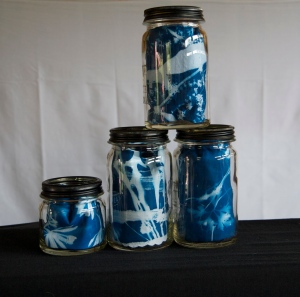
 These was testing whether they were to be with lids and what colour they should be. Use of lids contains it, closes it off. Colour of lids influences it also, the gold and blue adds a celestial element to the work. No lids subverts the function, it allows for contamination and possible pollution. (Which is what is happening to the natural world, our preservation attempts of this natural world is merely a token gesture by those who have to be seen to care, but it cannot affect profits of a few). Stacking methods of these bottles has also been trialled:
These was testing whether they were to be with lids and what colour they should be. Use of lids contains it, closes it off. Colour of lids influences it also, the gold and blue adds a celestial element to the work. No lids subverts the function, it allows for contamination and possible pollution. (Which is what is happening to the natural world, our preservation attempts of this natural world is merely a token gesture by those who have to be seen to care, but it cannot affect profits of a few). Stacking methods of these bottles has also been trialled: 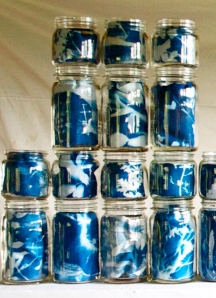
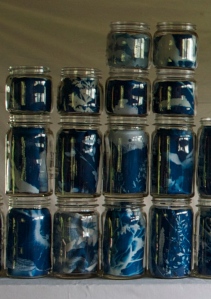
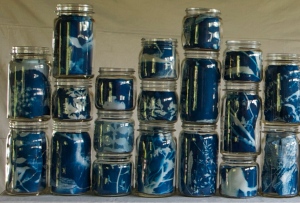 Ordered or random? Order would say that we go about the reduction of loss in an organized manner, I think that is not the case. While random is much closer to the way we try reduce these losses. Then it was how do we present a random stack? Where do we place something that is precious? As trying to preserve a loss or precious items is stored high, on shelves. Wide plinth was first trial, it was placed so that when you came around the corner (bottom right - the space on left is for one of my fellow students) into this communal space, part of the work could be seen, so hopefully pull the viewer into the space:
Ordered or random? Order would say that we go about the reduction of loss in an organized manner, I think that is not the case. While random is much closer to the way we try reduce these losses. Then it was how do we present a random stack? Where do we place something that is precious? As trying to preserve a loss or precious items is stored high, on shelves. Wide plinth was first trial, it was placed so that when you came around the corner (bottom right - the space on left is for one of my fellow students) into this communal space, part of the work could be seen, so hopefully pull the viewer into the space:  maybe black
maybe black 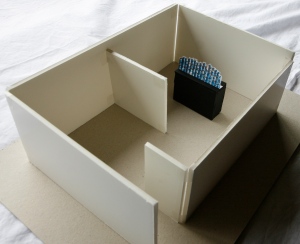 both these options felt funeral/entombment like. This too speaks of loss, but not the way I would like to say it. So moving them to other wall spaces:
both these options felt funeral/entombment like. This too speaks of loss, but not the way I would like to say it. So moving them to other wall spaces: 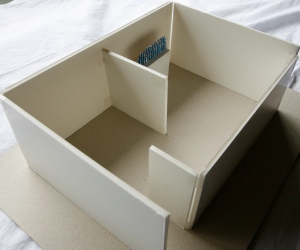

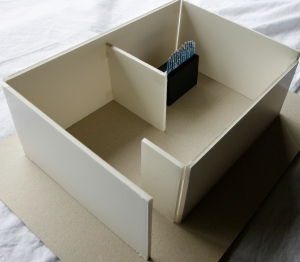 The size of the plinth felt clunky (not a great art word), too oppressive for the bottles. The black made the plinth too important, so to overcome this and to 'loose' the support, the plinth needed to be narrow, white and almost disappear into the wall:
The size of the plinth felt clunky (not a great art word), too oppressive for the bottles. The black made the plinth too important, so to overcome this and to 'loose' the support, the plinth needed to be narrow, white and almost disappear into the wall: 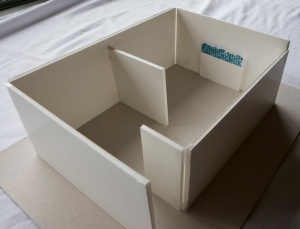 This has resolved one part of the work, am now working on the other wall spaces and how these can be brought into this work.
This has resolved one part of the work, am now working on the other wall spaces and how these can be brought into this work.
comments powered by Disqus
